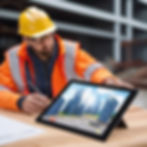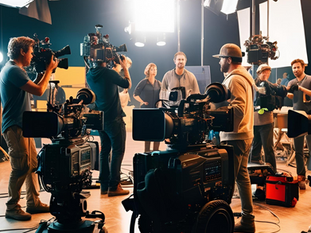
5D Modeling: A New Dimension in Spatial Analysis and Visualization
Oct 3, 2024
5 min read
3
44
0

In a world of growing complexity, traditional 3D modeling is beginning to show its limitations. As our urban landscapes expand, medical diagnostics become more precise, and space exploration ventures further into the unknown, the need for more sophisticated tools has become evident. The evolution from 2D to 3D modeling marked a significant leap in our ability to visualize and interact with spatial data. However, with today’s challenges, it’s clear that we require something even more advanced—a system that not only captures space but also incorporates time and perspective. Enter 5D modeling, a groundbreaking approach that redefines spatial analysis and visualization by adding the critical dimensions of time (the 4th dimension) and observer perspective (the 5th dimension).
This revolutionary concept, created by SwiftSight founder and CEO, Christopher Jones, is poised to reshape how industries interact with spatial data. The AURA system, set to be the first of its kind to implement 5D modeling, will elevate our ability to analyze and predict complex scenarios, offering insights previously thought impossible.
Understanding the Basics of 5D Modeling
5D modeling expands on conventional 3D models by incorporating time and observer perspective. Time allows us to see how a model changes across different moments, enabling predictions of future states. The observer’s perspective adds a personalized view, where the data adapts based on the user’s position and goals, offering a dynamic and context-rich understanding of any given scenario.
While 3D modeling provides a static representation of objects or environments, 5D modeling introduces dynamism and contextuality. It goes beyond simply depicting space; it shows how space evolves over time and how it can be perceived differently based on various viewpoints. This multidimensional approach offers a more comprehensive and nuanced understanding of spatial data, crucial for applications requiring high precision and adaptability.
Furthermore, the inclusion of the observer perspective in 5D modeling opens up intriguing possibilities for exploring concepts from quantum mechanics, particularly the observer effect. This principle, which suggests that the mere act of observation can alter the state of what is being observed, could have profound implications in how we interact with complex systems. By integrating the observer's influence as a functional component of the model, 5D modeling could provide deeper insights into the interconnectedness of variables in dynamic environments, potentially leading to more accurate predictions and a better understanding of causal relationships.1 2
The advent of 5D modeling is driven by cutting-edge technological advancements. Systems like SwiftSight’s AURA harness the power of AI, machine learning, and real-time data processing to bring 5D modeling to life. These technologies enable the integration of vast datasets from advanced sensors, processing them to deliver real-time, multidimensional insights. This leap in technology allows for real-time analysis and interaction with spatial data, setting new standards in accuracy and efficiency.
The Core Components of 5D Modeling
Time is a critical aspect of 5D modeling, allowing users to visualize changes over time and predict future scenarios. For example, the global market for 3D city modeling is expected to grow substantially, driven by its application in urban planning, where detailed visualization of changes over time aids in planning infrastructure and sustainable urban development (GIM International, MDPI).
The observer’s perspective is what truly personalizes 5D modeling. Depending on the user's position and objectives, the model adapts, providing a tailored view that enhances the relevance and usability of the data. This element also introduces the possibility of examining the observer effect—a concept from quantum mechanics where the act of observing can influence the state of the system. By modeling how observation impacts the scenario, we can gain a deeper understanding of dynamic systems and possibly uncover new insights into causality and prediction.
Real-time data is the backbone of 5D modeling, ensuring that the information presented is always current and relevant. This integration allows for immediate response and decision-making, which is crucial in fields like public safety, where every second counts, or in space exploration, where conditions can change rapidly (SpringerOpen).
Applications of 5D Modeling Across Industries
5D modeling has the potential to revolutionize urban planning by offering dynamic models that account for future growth, environmental changes, and infrastructure development. By 2026, the market for 3D modeling in urban planning is expected to exceed $7 billion, as cities increasingly adopt these technologies to manage urban expansion and sustainability (GIM International).
In healthcare, the applications of 5D modeling are transformative. Surgeons can use these models for planning complex procedures, allowing them to visualize not just the physical anatomy but also how it will change during the operation. This could improve the precision of robotic surgeries and reduce the risks associated with complex medical procedures (SpringerLink).
Space exploration stands to benefit enormously from 5D modeling. Navigating extraterrestrial environments requires precise, real-time data that can be adapted to changing conditions. 5D models can simulate environments on other planets, helping to plan missions, assess risks, and manage resources. The increasing investment in space exploration, expected to exceed $1 trillion by 2040, highlights the importance of advanced technologies like 5D modeling in ensuring mission success (SpringerOpen).
The Future of 5D Modeling
The future of 5D modeling is closely tied to emerging technologies like quantum computing and AI. These advancements will further enhance the capabilities of 5D models, allowing them to process even larger datasets with greater speed and accuracy. As these technologies mature, 5D modeling could become a standard tool across multiple industries, driving innovation and efficiency to new heights (SpringerLink).
As 5D modeling becomes more integrated into various sectors, its impact will be profound. Industries like healthcare, urban planning, and space exploration will see significant advancements in how they operate, leading to better outcomes and more sustainable practices. The ability to predict, analyze, and adapt to complex scenarios in real-time will make 5D modeling indispensable.
SwiftSight is at the forefront of this technological revolution with its AURA system. AURA exemplifies the power of 5D modeling, offering advanced tools that transform how industries approach spatial analysis and visualization. With a commitment to innovation and societal impact, SwiftSight is paving the way for a future where 5D modeling is the norm, not the exception.
5D modeling represents a significant leap forward in spatial analysis and visualization. By incorporating time and observer perspective, it offers a richer, more dynamic understanding of the world around us. As industries begin to harness the power of 5D modeling, the possibilities for innovation are endless. For those looking to stay ahead of the curve, exploring SwiftSight’s AURA system is a compelling next step toward embracing the future of spatial technology. The journey from 3D to 5D modeling is not just an evolution; it’s a revolution in how we perceive and interact with our environment—a revolution that promises to shape the future in ways we are only beginning to imagine.
Referenced Sources:
Shivam, P., Narayan, P. (2024). 3D Visualization of Terrain Surface for Enhanced Spatial Mapping and Analysis. In: Puthal, D., Mohanty, S., Choi, BY. (eds) Internet of Things. Advances in Information and Communication Technology. IFIPIoT 2023. IFIP Advances in Information and Communication Technology, vol 684. Springer, Cham. https://doi.org/10.1007/978-3-031-45882-8_4
Prof. Dr. Volker Coors (2020). The Applications of 3D-City Models in Urban Studies. Institute of Applied Research, HFT Stuttgart, Faculty of Surveying, Computer Science and Mathematics, Schellingstr. 24, 70174 Stuttgart, Germany IJGI | Special Issue : The Applications of 3D-City Models in Urban Studies (mdpi.com)
Supporting urban spaces with UAV mapping and 3D modelling Unexplored promotion and management tools for urban regeneration https://www.gim-international.com/content/article/supporting-urban-spaces-with-uav-mapping-and-3d-modelling
.png)





